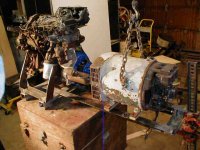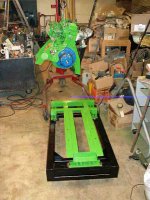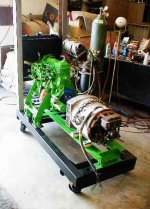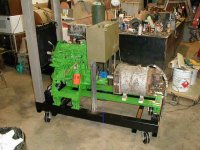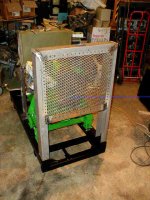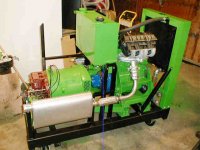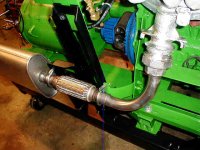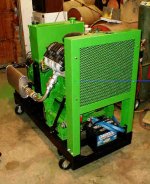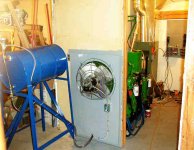This may be off topic for an audio forum but it is inkeeping with the spirit of DIY that some of us here take to extremes as a lifestyle. I resemble this remark! 
Back at Christmas we had an ice storm and simultaneous power failure. When I started my POS Briggs & Stratton powered 3 kW standby power plant it finally did exactly what it was supposed to do by design, ran for about 30 seconds and then committed suicide for lack of oil. Beware all those light duty 3600 RPM power plants that they sell at Home Dumpo and places like that. They are designed to run about 30 days and that's IT! Mine made more noise than electricity while it worked.
I have wanted something that turned slower thus making less noise and lasting much longer between overhauls, and ran on diesel (so that I could also run alternative fuels rather than expensive gasoline only).
Back in Y2K I had purchased an old VW Jetta and towed it home for the engine which I removed and had been sitting in my shop for the past five years with the intention of building a good standby generator with it. This was all the incentive I finally needed to get started on that project again!
In the past three months, starting from scratch I built all the framework, a custom flex coupler to drive the alternator from the flywheel (you cannot purchase one for this application as it is just plain wierd on the VW engine) and everything else. All parts including engine and alternator were sandblasted prior to painting and assembly. I now have a fully functional co-generating water cooled power plant in the 12 kW class that not only can power my shop and home, but also heats my shop when running. It is a real miser on fuel too which is why I chose to use the 1.6 Litre VW engine from stories I'd heard. They are true! I have heard they will idle for about 7 hours on a gallin of fuel. I haven't tried this but i believe it. At 4 kW constant load it uses about 2.2 litres per hour. That works out to about 0.55 litres of fuel per kW hour. I governor regulate the engine speed at 1800 RPM.
Here are a few pictures of the project beginning with an early shot of the engine on a freshly conceived motor mount and subframe that will allow the engine and alternator to float on the main frame suspended by 24 small block Chevy valve springs. I should add the main frame rails made of 3x6" box tubing are filled with sand to keep them from vibrating and ringing, a good audiophile technique!
The last pic shows the way the unit is installed in my furnace room. I decided to share the existing gas furnace chimney as an exhaust stack for the engine. This setup worked out great!
I have the system outfitted with a duel fuel supplies, each with it's own filter farm. One system also employs a DIY oil preheater and water extractor using hot engine coolant. I can run this system on WVO, WMO, etc. The blue day tank actually contains waste transmission fluid and motor oil mix. The engine under a 9 kW load works noticeable better, with a smaller throttle opening (better fuel economy) on the waste oil than it does on new store bought diesel. This is because there iis a lot more energy in the heavy oil.
I still have to build the genset control panel box which will mount on the bracket sticking up next to the onboard fuel tank. I also have to do proper permanent wiring.
I am on my way to energy self sufficiency with this plant. Once I have my wind turbine built and running (hopefully this year), and a much smaller diesel power plant which will give me insurance and run 24/7 delegating this plant to just use when I'm working in the shop (its 3-phase power can run my machine shop), or doing rebuild, repair and maintaining other systems I'll be all set to call the power utility and cancel my service.
Back at Christmas we had an ice storm and simultaneous power failure. When I started my POS Briggs & Stratton powered 3 kW standby power plant it finally did exactly what it was supposed to do by design, ran for about 30 seconds and then committed suicide for lack of oil. Beware all those light duty 3600 RPM power plants that they sell at Home Dumpo and places like that. They are designed to run about 30 days and that's IT! Mine made more noise than electricity while it worked.
I have wanted something that turned slower thus making less noise and lasting much longer between overhauls, and ran on diesel (so that I could also run alternative fuels rather than expensive gasoline only).
Back in Y2K I had purchased an old VW Jetta and towed it home for the engine which I removed and had been sitting in my shop for the past five years with the intention of building a good standby generator with it. This was all the incentive I finally needed to get started on that project again!
In the past three months, starting from scratch I built all the framework, a custom flex coupler to drive the alternator from the flywheel (you cannot purchase one for this application as it is just plain wierd on the VW engine) and everything else. All parts including engine and alternator were sandblasted prior to painting and assembly. I now have a fully functional co-generating water cooled power plant in the 12 kW class that not only can power my shop and home, but also heats my shop when running. It is a real miser on fuel too which is why I chose to use the 1.6 Litre VW engine from stories I'd heard. They are true! I have heard they will idle for about 7 hours on a gallin of fuel. I haven't tried this but i believe it. At 4 kW constant load it uses about 2.2 litres per hour. That works out to about 0.55 litres of fuel per kW hour. I governor regulate the engine speed at 1800 RPM.
Here are a few pictures of the project beginning with an early shot of the engine on a freshly conceived motor mount and subframe that will allow the engine and alternator to float on the main frame suspended by 24 small block Chevy valve springs. I should add the main frame rails made of 3x6" box tubing are filled with sand to keep them from vibrating and ringing, a good audiophile technique!
The last pic shows the way the unit is installed in my furnace room. I decided to share the existing gas furnace chimney as an exhaust stack for the engine. This setup worked out great!
I have the system outfitted with a duel fuel supplies, each with it's own filter farm. One system also employs a DIY oil preheater and water extractor using hot engine coolant. I can run this system on WVO, WMO, etc. The blue day tank actually contains waste transmission fluid and motor oil mix. The engine under a 9 kW load works noticeable better, with a smaller throttle opening (better fuel economy) on the waste oil than it does on new store bought diesel. This is because there iis a lot more energy in the heavy oil.
I still have to build the genset control panel box which will mount on the bracket sticking up next to the onboard fuel tank. I also have to do proper permanent wiring.
I am on my way to energy self sufficiency with this plant. Once I have my wind turbine built and running (hopefully this year), and a much smaller diesel power plant which will give me insurance and run 24/7 delegating this plant to just use when I'm working in the shop (its 3-phase power can run my machine shop), or doing rebuild, repair and maintaining other systems I'll be all set to call the power utility and cancel my service.
Attachments
Thanx for the comments and compliments guys!
MARK asked a rather personal question. I've never been asked how long my chimney was before. About 12 feet I think from point of insertion. No problem. This is quite a small displacement engine at 1600cc (~90 cu.in.). I used an automotive muffler for a 300 cu.in. V-6 and 2-1/4" pipe after the muffler into the 6" chimney. Bends are gentle radius on the pipe to the muffler and way less than 90 degrees on the output of the muffler.
About 12 feet I think from point of insertion. No problem. This is quite a small displacement engine at 1600cc (~90 cu.in.). I used an automotive muffler for a 300 cu.in. V-6 and 2-1/4" pipe after the muffler into the 6" chimney. Bends are gentle radius on the pipe to the muffler and way less than 90 degrees on the output of the muffler.
Sch3mat1c is concerned that it is a POC and green. Since it is a power generator is POC anything like PUC? If so don't worry, it is the farthest thing you can get to a PUC. In fact, I built it to get them guys the PUC out of my face!
If so don't worry, it is the farthest thing you can get to a PUC. In fact, I built it to get them guys the PUC out of my face!  (I plan to go off grid once I have additional equipment built). As to the color, this is the first 'thing' I ever built that I ever painted green. I think it looks good on a generator. Deere John thinks it looks good on his tractor. Thanx for the kind compliment.
(I plan to go off grid once I have additional equipment built). As to the color, this is the first 'thing' I ever built that I ever painted green. I think it looks good on a generator. Deere John thinks it looks good on his tractor. Thanx for the kind compliment.
killowattski cautioned about CO. Yes, I am watching my situation. There is a net flow of air out of the room up the chimney by the suction caused by the escaping exhaust gasses. The bottom of the chimney is open to the room inside the gas furnace. Room air is sucked into the chimney this way. This and the fact that the building is large and not very air tight will help. I have two of those big roll up doors and they leak.
MARK asked a rather personal question. I've never been asked how long my chimney was before.
Sch3mat1c is concerned that it is a POC and green. Since it is a power generator is POC anything like PUC?
killowattski cautioned about CO. Yes, I am watching my situation. There is a net flow of air out of the room up the chimney by the suction caused by the escaping exhaust gasses. The bottom of the chimney is open to the room inside the gas furnace. Room air is sucked into the chimney this way. This and the fact that the building is large and not very air tight will help. I have two of those big roll up doors and they leak.
Now the BAD NEWS
What I didn't tell you is that after all this hard work I discovered that my diesel engine is baffed. There was no way to really test it until I was 80% completed in the project. It has huge blowby and almost no oil pressure. I have been searching for another engine to drop in and it looks like I have found one. Having mine rebuilt properly by an engine machine shop is not an option due to the cost. This means I have to uninstall the plant, remove the engine, power wash, sandblast and paint the replacement, chase all the threads in the block that I use to mount to standard north american threads instead of metric, etc.etc. etc. Lots more work.
I plan to take this opportunity to make a custom, much larger capacity oil sump from the stock oil pan.
Despite my DIY tendencies, at this point I'm quite tired of working on it and wish I could have just gone out and bought a suitable plant, but there isn't anything out there I've found that fits the compact size requirements I have to live with. Everything I've seen is too long to allow furnace access and too wide to fit through the 27" wide door.
THE GOOD NEWS. I built my plant on wheels!
What I didn't tell you is that after all this hard work I discovered that my diesel engine is baffed. There was no way to really test it until I was 80% completed in the project. It has huge blowby and almost no oil pressure. I have been searching for another engine to drop in and it looks like I have found one. Having mine rebuilt properly by an engine machine shop is not an option due to the cost. This means I have to uninstall the plant, remove the engine, power wash, sandblast and paint the replacement, chase all the threads in the block that I use to mount to standard north american threads instead of metric, etc.etc. etc. Lots more work.

I plan to take this opportunity to make a custom, much larger capacity oil sump from the stock oil pan.
Despite my DIY tendencies, at this point I'm quite tired of working on it and wish I could have just gone out and bought a suitable plant, but there isn't anything out there I've found that fits the compact size requirements I have to live with. Everything I've seen is too long to allow furnace access and too wide to fit through the 27" wide door.
THE GOOD NEWS. I built my plant on wheels!
diesel woes
Being a long time vw diesel mech, I was going to mention that, but I thought I'd not trouble you. Oldie=not goodie.
These motors last a longtime only because the owners do not notice them wearing out! (just slower...& slower...) Typically the bores are worn way oval and the compression (due to rings) is barely enuff to run. Also when the hedgasket fails, it's the block that warps, so standard gas engine cyl. head refacing does nothing.
I have a good one in my driveway, but it's attached to a car and going to my brother in upstate NY.>>Doug
Being a long time vw diesel mech, I was going to mention that, but I thought I'd not trouble you. Oldie=not goodie.
These motors last a longtime only because the owners do not notice them wearing out! (just slower...& slower...) Typically the bores are worn way oval and the compression (due to rings) is barely enuff to run. Also when the hedgasket fails, it's the block that warps, so standard gas engine cyl. head refacing does nothing.
I have a good one in my driveway, but it's attached to a car and going to my brother in upstate NY.>>Doug
Doug,
Thanx for adding your insight. I didn't know that about the block warpage as opposed to the head. Are you suggesting that merely putting in fresh rings (and a bore crosshatch with a deglazing stone, not a full overbore) might be enough to restore compression on a well used VW 1.6D? This assumes the valves are sealing of course.
There is a diamond shaped inspection cover with two bolts holding it on the side of the block that the FI pump is on just forward of the oil filter mount. Can you tell me what this is for and if it would be a good place to place a hose connection to vent engine blowby from? VW apparently had a simple 'cure' that prevented the way blowby is relieved in the stock engine from the valve cover hose connection, to one that did not allow this flow up the oil return passages from the head.
I have so much oil accumulation upstairs that cannot get back down due to the high blowby flow up into the valve cover. This eventually overwhelms my DIY oil separator and resumes pushing engine oil into the two intake runners. I get a very smoky exhaust when this occurs and before I built the cannister I had engine run away syndrome. Yesterday I put long transparent braided vinyl vertical hoses between the valve cover vent and my separator and now the oil doesn't get quite as far as my separator and the engine exhaust stayed the best I've seen it. The motor ran better and there was no liquid oil coming out of the exhaust manifold. That puky mess was because the pool of excess oil in the head, and the overpressure was forcing oil into the exhaust ports through the exhaust valve guides. With my longer hoses two feet vertically to the separator cannister this has stopped.
Besides still being hard to start it looks like I could actually use this engine for some time if I merely fix the oil pump. It appears that the bypass is stuck open. It makes the power I need at 1800 RPM and is acceptably miserly on fuel. Unfortunately to access the oil pump is the exact same effort as putting in a new engine.
Thanx for adding your insight. I didn't know that about the block warpage as opposed to the head. Are you suggesting that merely putting in fresh rings (and a bore crosshatch with a deglazing stone, not a full overbore) might be enough to restore compression on a well used VW 1.6D? This assumes the valves are sealing of course.
There is a diamond shaped inspection cover with two bolts holding it on the side of the block that the FI pump is on just forward of the oil filter mount. Can you tell me what this is for and if it would be a good place to place a hose connection to vent engine blowby from? VW apparently had a simple 'cure' that prevented the way blowby is relieved in the stock engine from the valve cover hose connection, to one that did not allow this flow up the oil return passages from the head.
I have so much oil accumulation upstairs that cannot get back down due to the high blowby flow up into the valve cover. This eventually overwhelms my DIY oil separator and resumes pushing engine oil into the two intake runners. I get a very smoky exhaust when this occurs and before I built the cannister I had engine run away syndrome. Yesterday I put long transparent braided vinyl vertical hoses between the valve cover vent and my separator and now the oil doesn't get quite as far as my separator and the engine exhaust stayed the best I've seen it. The motor ran better and there was no liquid oil coming out of the exhaust manifold. That puky mess was because the pool of excess oil in the head, and the overpressure was forcing oil into the exhaust ports through the exhaust valve guides. With my longer hoses two feet vertically to the separator cannister this has stopped.
Besides still being hard to start it looks like I could actually use this engine for some time if I merely fix the oil pump. It appears that the bypass is stuck open. It makes the power I need at 1800 RPM and is acceptably miserly on fuel. Unfortunately to access the oil pump is the exact same effort as putting in a new engine.
ok, so only a few years late ...
I was just curious if you have any addtional pictures of the design setup you used. I happen to have a factory fresh 1.6 sitting in my garage, and while i had planned on dropping it into another vehicle, the fact is that i could use it running WVO to power my biodiesel plant.
So anything you can give me would be nice. design pictures, pitfalls, things you would do different, etc.
I was just curious if you have any addtional pictures of the design setup you used. I happen to have a factory fresh 1.6 sitting in my garage, and while i had planned on dropping it into another vehicle, the fact is that i could use it running WVO to power my biodiesel plant.
So anything you can give me would be nice. design pictures, pitfalls, things you would do different, etc.
- Status
- This old topic is closed. If you want to reopen this topic, contact a moderator using the "Report Post" button.
- Home
- General Interest
- Everything Else
- DIY VW diesel plant makes electricity
